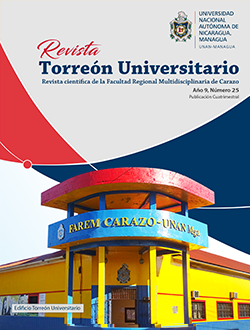Lead removal in aqueous solution using polyacrylamide-based cryogels as adsorbent: Balance study in batch mode
DOI:
https://doi.org/10.5377/torreon.v9i25.9855Keywords:
MPAAG-TBA Cryogels, removal, adsorption capacity, isotherms, Lead (Pb2 ), LeadAbstract
The objective of this research was to remove lead (Pb2+) ions from aqueous solutions using macroporos polyacrylamine gel (MPAAG) called cryogels as an adsorbent material. The MPAAG, were prepared by a free radical co-polymerization reaction of acrylamide (AAm) and allyl glycidyl ether (AGE) and N, N-methylene-bis (acrylamide) (MBAAm) bonded to epoxy functional groups (epoxy-pAAm) at a concentration of 7,5%, the reaction was carried out at -12 oC for 1 hour. After the preparation process, MPAAG was evaluated by binding the tris (2aminoethyl) amine (TREN) ligand groups followed by bromoacetic acid (BA). The presence of the amide and carboxyl group in the structure of the cryogels allowed the removal of lead to apply in aqueous solutions. The ability to remove lead on the MPAAG-TBA has been determined at different pH, metal concentrations and contact times. The technique used for the determination of lead in the aqueous solution was the Atomic Absorption Spectrophotometer (AAS). The maximum adsorption capacity of lead on the MPAAG-TBA was 10,78 mg/L at pH5 in 30 minutes. Adsorption equilibrium was performed at concentrations of 20,72; 41,44; 82,88 and 165,75 mg/L respectively of lead ions on the MPAAG-TBA results obtained were adjusted with the Langmuir and Freundlich model. The maximum adsorption capacity was determined by the Lagmuir model, the adsorption intensity (RL) values were lower than one, indicating that the adsorption of lead on the MPAAG-TBA is favorable; however it did not fit the model in the first two concentrations. The regression coefficient (R2) was used the Freundlich model and the intensity values (n) were found in the range of 1 to 10 considering the process of lead removal on the MPAAG-TBA was favorable. The results indicate that MPAAG-TBA criogels could be used as adsorbent material to remove ions Pb2+ present in aqueous solution at low concentration.
Downloads
Downloads
Published
How to Cite
Issue
Section
License
Los autores que publican en esta revista están de acuerdo con los siguientes términos.
- El autor o los autores de los artículos, ensayos o investigaciones conceden a la Universidad Nacional Autónoma de Nicaragua, Managua (UNAN-Managua) los derechos de edición (copyright) del trabajo enviado, por consiguiente la Universidad cuenta con el derecho exclusivo para publicar el artículo durante el periodo completo de los derechos de autor.
- Estos derechos de autor/ autores autorizan a la Revista Torreón Universitario y a la Universidad editar y divulgar/publicar el artículo en dicha Revista, incluyendo reproducción impresa y electrónica, el almacenamiento, recuperación y cualquier otro tipo de publicación, y fuentes de información secundaria como servicios de resúmenes y bases de datos, así mismo la facultan a proteger el artículo contra el uso no autorizado para su difusión por medios impresos o electrónicos (PDF, HTML, EPUB, XML u otros).
Licencia para el uso del contenido
La revista hace uso de la Licencia Creative Commons Atribución-NoComercial-SinDerivar 4.0 Internacional.
Bajo esta declaración:

Este revista está sujeta a una licencia de Creative Commons Reconocimiento-NoComercial-SinObraDerivada 4.0 Internacional. Puede ser copiada, distribuida y transmitida públicamente siempre y cuando se cite al autor y la fuente (Revista Torreón Universitario), no debe modificarse ni utilizarse con ningún fin comercial. La licencia completa se puede consultar en http://creativecommons.org/licenses/by-nc-nd/4.0/.

